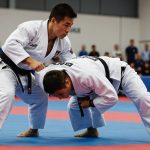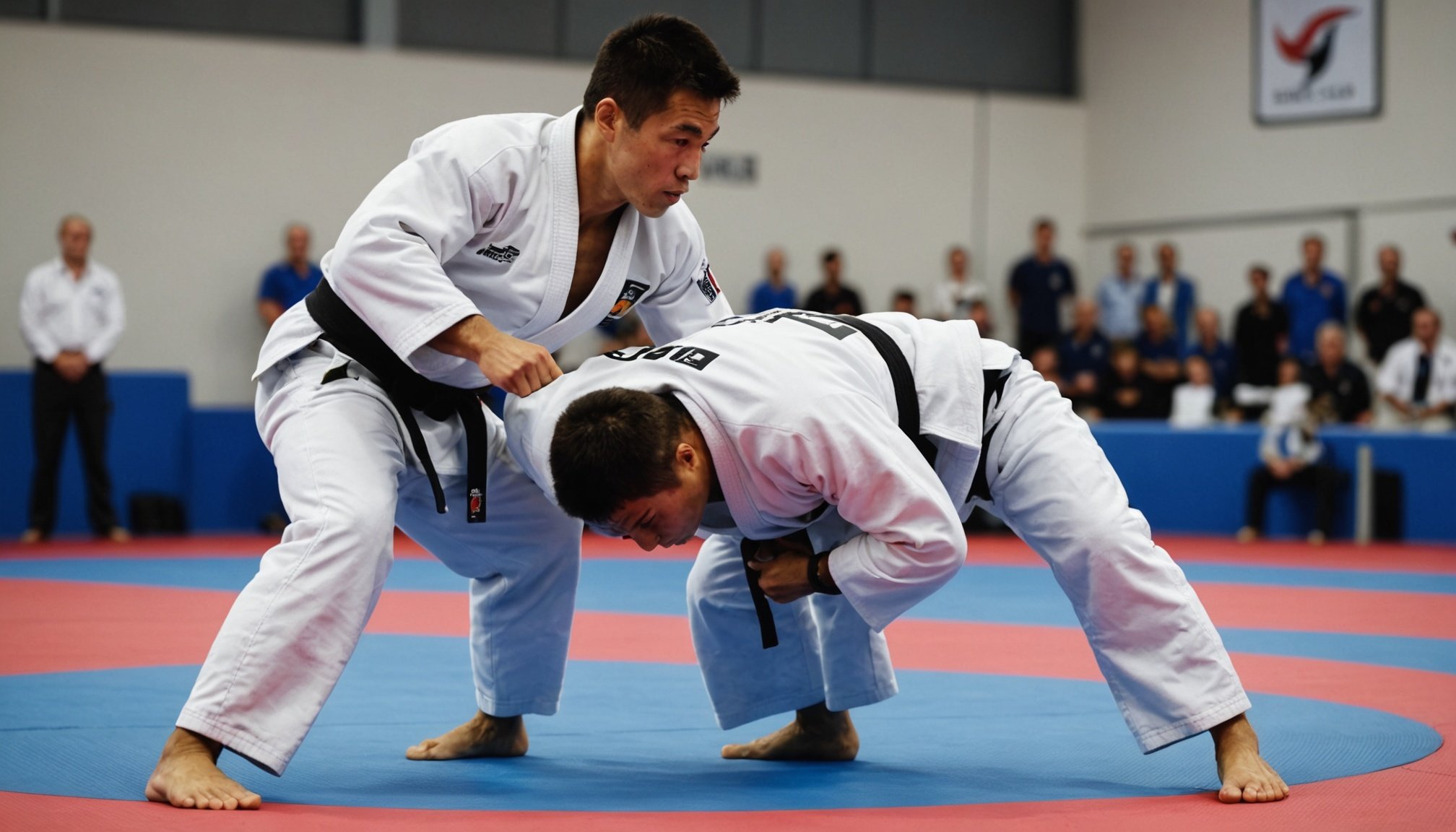Unlocking Breakfall Expertise: Essential Tactics for UK Judo Coaches to Elevate Athlete Performance
Understanding the Importance of Breakfall Techniques in Judo
Breakfall techniques, or ukemi in Japanese, are the cornerstone of judo training, serving as a critical component in ensuring athlete safety and enhancing overall performance. These techniques are designed to help judokas absorb the impact of falls seamlessly, thereby reducing the risk of injury. For UK judo coaches, mastering and teaching breakfall skills is not just a necessity but a key strategy to elevate athlete performance.
“Breakfall techniques are fundamental in judo for ensuring athlete safety,” emphasizes a judo coaching expert. “They are crucial for injury prevention, allowing judokas to absorb impact seamlessly and reduce the risk of harm”[1].
Have you seen this : Unlocking mental resilience: effective techniques for uk combat sports athletes to overcome performance anxiety
Key Principles of Effective Breakfall Execution
To execute breakfalls effectively, several key principles must be adhered to:
Distributing Body Impact
Judokas must learn to distribute their body’s impact over a larger area to minimize stress on specific joints or muscles. This technique helps in dispersing the force of the fall, making it safer and less likely to cause injury.
Also to discover : Maximizing performance: a complete guide to incorporating cognitive training into the everyday habits of uk judo athletes
Protecting the Head and Neck
Keeping the head tucked and the chin down is essential to shield the neck and head from direct impact. This simple yet crucial action can significantly reduce the risk of head and neck injuries.
Consistent Practice
Consistent practice is vital for forming muscle memory, which is crucial during fast-paced matches. Repetition helps athletes to instinctively perform breakfalls correctly, even under pressure.
Effective Coaching Strategies for Breakfalls
Successfully enhancing athlete performance in breakfalls requires a comprehensive understanding of coaching strategies. Here are some key approaches:
Developing a Structured Training Plan
Creating a structured training plan is critical to instilling discipline and consistency in judo drills. Coaches should establish a clear sequence of drills tailored to each athlete’s current skill level. Ensuring these plans are well-organized maximizes efficiency and improvement in technical execution.
- **Beginner Drills**: Start with basic backward rolls and side falls on a soft mat.
- **Intermediate Drills**: Introduce forward rolls and more complex falling techniques.
- **Advanced Drills**: Incorporate standing breakfalls and breakfalls from running jumps.
Incorporating Progressive Drills
Drills should gradually increase in complexity and intensity to build foundational skills effectively. Initially, focus on mastering fundamental techniques. As proficiency increases, introduce advanced variations to challenge athletes and prevent skill plateaus.
Monitoring Athlete Progress and Adaptations
Regularly evaluating athlete performance is crucial. Use evaluation tools like video analysis and feedback sessions to track improvements and identify areas needing extra focus. Adaptations to training plans should consider individual growth rates and learning paces. Personalizing adjustments ensures continued development and motivation.
Essential Drills to Teach Breakfall Skills
Teaching breakfall skills effectively involves a step-by-step approach, starting from the basics and progressing to more advanced techniques.
Basic Drills
Begin with simple backward rolls and side falls. For instance, have athletes kneel on a soft mat to practice backward rolls, ensuring the head is tucked and the arms protectively encircle the body. This fundamental practice helps newcomers develop confidence and muscle memory.
Advanced Drills
As athletes progress, their training methods can incorporate more challenging drills. Standing breakfalls, for example, challenge an athlete’s balance and timing. Effective training methods here involve controlled descent from a low squat position up to a standing height, still adhering to the principles of body protection.
Overcoming Common Challenges in Teaching Breakfalls
Teaching breakfalls can come with several challenges, particularly when dealing with athletes who are hesitant or fearful of falling.
Addressing Fears and Hesitations
Understanding and addressing these fears is key. Athletes might worry about injury or the unfamiliar sensation of falling. One effective way is to build trust through gradual exposure. Start with low-impact falls to help the athlete gain confidence in their ability to perform more complex techniques later.
Tailoring Techniques to Individual Needs
Coaching isn’t one-size-fits-all. Each athlete may grapple with different obstacles, whether they are physical or mental. Determining these individual challenges enables coaches to personalize training. Embracing unique learning styles, whether visual or kinaesthetic, ensures athlete engagement and efficacy.
Creating a Positive Learning Environment
Encouragement is vital. Athletes thrive with consistent motivation and positive reinforcement. Creating a supportive atmosphere can minimize anxiety and help learners focus on improving their skills. Celebrate small victories, acknowledge progress, and offer constructive feedback.
Practical Insights and Actionable Advice
For UK judo coaches looking to elevate athlete performance, here are some practical insights and actionable advice:
-
Focus on Defensive Skills: Developing defensive skills, such as falls and grip techniques, can minimize the likelihood of injuries sustained while under attack. This is particularly important during high-intensity periods of combat, such as the last minute and golden score[2].
-
Incorporate Anaerobic Endurance Training: Incorporating anaerobic endurance training can help mitigate fatigue-related injuries, especially for female athletes during the final phases of combat. This type of training enhances the athlete’s ability to perform at high intensity over extended periods[2].
-
Use Real-Time Monitoring: Utilize real-time monitoring systems to identify early signs of fatigue-related risk factors during matches. This proactive approach can help in preventing injuries by allowing coaches to intervene early[2].
Table: Differences in Injury Rates During Different Phases of Judo Matches
Here is a comparative table highlighting the differences in injury rates during various phases of judo matches:
| Injury Location | First Half | Last Half | Last Minute | Golden Score | Difference (1-2) | Difference (1-3) | Difference (1-4) |
|---|---|---|---|---|---|---|---|
| Skull | 2 (3%) | 6 (6.5%) | 6 (7.1%) | 1 (10%) | -4 (-3.5%) | -4 (-4.2%) | 1 (-7%) |
| Face | 1 (1.5%) | 4 (4.3%) | 5 (6%) | 1 (10%) | -3 (-2.8%) | -4 (-4.5%) | 0 (-8.5%) |
| Forearm | 0 (0%) | 1 (1.1%) | 1 (1.2%) | 0 (0%) | -1 (-1.1%) | -1 (-1.2%) | 0 (0%) |
| Wrist | 2 (3%) | 2 (2.2%) | 0 (0%) | 0 (0%) | 0 (0.8%) | 2 (3%) | 2 (3%) |
| Hand/Finger | 3 (4.5%) | 7 (7.5%) | 3 (3.6%) | 0 (0%) | -4 (-3.1%) | 0 (0.9%) | 3 (4.5%) |
Quotes and Anecdotes
-
“Remember to tuck your chin,” advises Yuri Marmerstein, a martial arts expert. “This simple action can make a significant difference in protecting your head and neck during breakfalls”[3].
-
A seasoned judo coach notes, “Creating a positive learning environment is crucial. Athletes thrive with consistent motivation and positive reinforcement. Celebrate small victories, acknowledge progress, and offer constructive feedback to keep them motivated and engaged.”
Mastering breakfall techniques is a multifaceted process that requires a deep understanding of judo mechanics, effective coaching strategies, and a supportive learning environment. By focusing on structured training plans, progressive drills, and individualized coaching, UK judo coaches can significantly elevate athlete performance while ensuring safety.
In the words of a judo black belt, “Breakfalls are not just about falling; they are about mastering the art of falling safely and efficiently. With the right training and mindset, athletes can transform their fear of falling into a powerful tool for success in judo.”
By integrating these strategies into their coaching practices, UK judo coaches can help their athletes become more adept, resilient, and successful in the world of judo. Whether you are a beginner or an advanced practitioner, the journey to mastering breakfalls is one that requires dedication, patience, and the right guidance. With the right approach, you can unlock the full potential of your athletes and help them achieve greatness in this dynamic and rewarding martial art.





